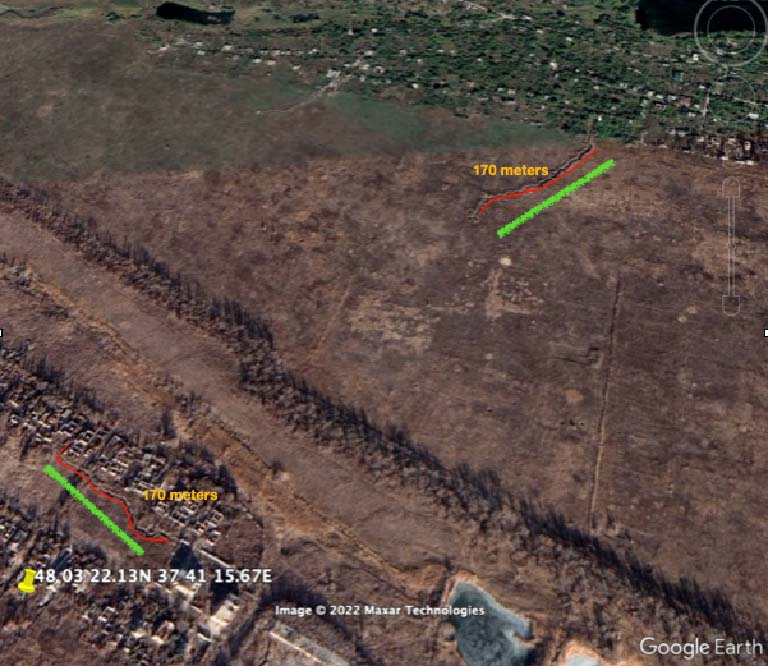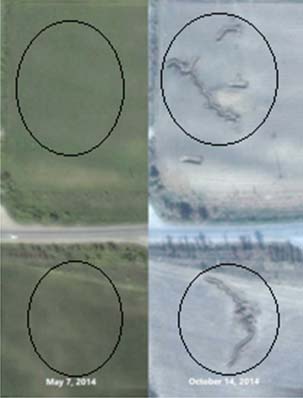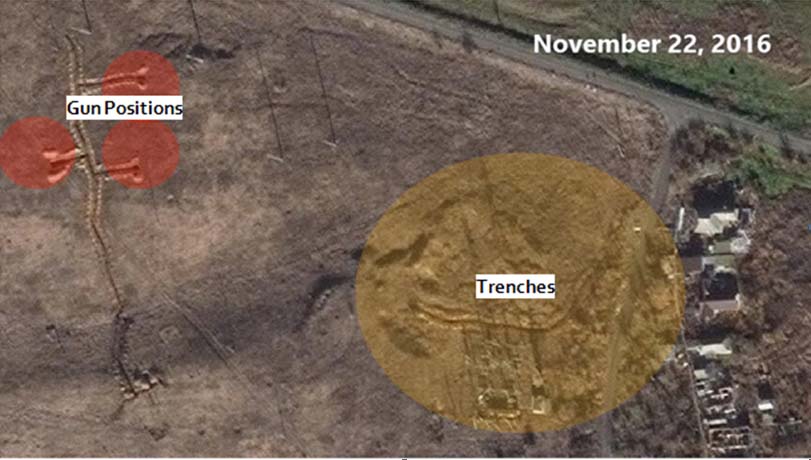The characteristics of war are rapidly changing in the 21st century. This change is due to the induction of latest weapon systems that can track and destroy enemy positions with pinpoint accuracy while reducing collateral damage. We are also witnessing new evolution in the modern battle field where-in man-portable weapons systems are playing vital role in deciding the course of war. The Ukraine–Russia war is a current example of how man-portable Anti Tank/Anti Tank Aircraft Guided Missile systems are proving to be effective against Russian’s military hardware. Aerial drones and satellite guidance are able to pinpoint enemy position and call in for aerial and artillery strikes. As such defenses against such an evolving threat are becoming a present day challenge.
One of the effective and proven ways to overcome these challenges and to protect infantry units from enemy’s hostile fire is the use of trenches[1]. In the ongoing Ukraine-Russia war one can see the extensive use of the trenches to mitigate these challenges. As the Ukraine – Russia war continues, both sides have built elaborate network of trenches to defend their territories from enemy fire. Therefore, the article focuses on understanding the role trench warfare and its relevance in modern day battlefield with specific reference to ongoing Ukraine –Russia war using open source satellite imagery.
One of the effective and proven ways to overcome these challenges and to protect infantry units from enemy’s hostile fire is the use of trenches…. In the ongoing Ukraine-Russia war one can see the extensive use of the trenches to mitigate these challenges.
In the 17th century Sébastien Le Prestre de Vauban[2] laid out the basic tenets of trench warfare. Though this was not intended for the modern day version of trench warfare like the case in First World War, it genesis has been well marked. The primary reason behind waging trench warfare was to reduce the number of casualties and provide a fortified position for soldiers against the enemy forces. Many strategic experts including noted American military theorist and Professor Dennis Hart Mahan criticized the “open frontal assault as a careless disregard of life,” moreover Mahan argued that “American soldier must fight with tactical principles that ensured minimum risk while they retained offensive capability.” The American and European military experts realized that frontal assault should be carried out when one has an advantage of surprise; otherwise the more suited alternative is to use trenches that provide better protection and expected results in the battlefield. Anthony Saunders in the book Trench Warfare 1850 – 1950, describes “the trench warfare is a military operations between two entrenched armies, in which neither side can breach or outflank the defenses of the other so that breakthrough cannot be achieved, irrespective of the size or type of operation carried out to achieve that aim.” It is important to note the infantry tactics to break the stalemate caused by trench warfare eventually led to more death and destruction on both sides.[3] To overcome the stalemate, maneuver warfare tactics were developed. Yet the utility of trenches for defensive posture has remained in use ever since. Therefore, the trench warfare is likely to remain a major form of tactics in future wars too.
It is important to note the infantry tactics to break the stalemate caused by trench warfare eventually led to more death and destruction on both sides. To overcome the stalemate, maneuver warfare tactics were developed.
History – Strategy and Tactics
In the middle-centuries trench warfare developed due to long drawn siege warfare laid on forts. The offensive actions would last for months in most cases and were under a constant barrage of projectile weapons like spears and arrows from the fort. Any attempt at breaching the forts always met with stiff resistance with these kinds of weapons making the affront vulnerable and exposed to defenders[4]. All through the history of siege warfare, the use of trenches have become an inalienable part of defensive tactics. It has been used in almost all battles and conflict zones all through to the First and Second World Wars, where it attained a position of study and analysis for the conduct of wars. The one reason that made trench warfare the mainstay of the World-War I was the introduction of heavy artillery[5]. These new weapons had very high explosion radius and the only way to be safe from them was either to hide underground or through the evasion in trenches. Thus the use of trenches was fortified as the most practical way for setting up defensive positions and has remained till date as a preferred strategy.
Based on the battle objectives, geography of the terrain, and the type of the weapons deployed, different types of trenches were made[6]. They are usually made along a natural feature like the rivers, or tree lines, or natural mounds. This would enhance the security of the trench due to its design and structure. If hit by a shell or any form of attack only one section of the trench would get affected. The Figure 1 shows the German trench with a single line of fire. Major J. A. Moss’s Manual of Military Training, best describes these preparations along with German and British field Engineering Manuals. The firing section was often placed for machine guns “with a view to bringing a powerful enfilade or oblique fire on the attackers after they have reached range of the weapon, to flanking supporting works, and to sweeping any gaps that have been left in the line of obstacles” Figure 3 illustrates the four different kind of trenches were used for various purpose during world wars, that includes of firing sections, traversing sections, support and communication sections, and combination trenches.
The trench design facilitates the type of assault that was planned, which an obstacle zone had followed by the main firing section and a separate support and reserve section. Besides the advantage of a better field of view and of fire afforded by occupation of high ground the additional advantages follow:
(a) The crests will conceal the dispositions in depth from the enemy’s view.
(b) The enemy’s assault will be made more exhausting by compelling him to ascend the slopes.
(c) Good facilities will be afforded for launching a counter attack.
(d) The possibility of providing several tiers of fire will sometimes be offered. The trenches also had fortified bunkers with de-filade construction for protection against enemy fire.
..four different kind of trenches were used for various purpose during world wars, that includes of firing sections, traversing sections, support and communication sections, and combination trenches.
As the trench warfare became mainstay of fighting strategy and tactics during World Wars, its use and design became methodical. Trenches during the First and Second World War were built to the specification and size to meet the tactical requirements. The length of the trench at this time could be as long as 475 miles long in the western front. Trenches not only provided a fortified position but also have been used as a line of communication. The Maginot line built by France as a defence against Germany was a 280 mile long fortification through a series of connected trenches, pits and Gun positions and underground fortification with bunkers. “The space between the opposing trenches was referred to as “no man’s land” and varied in width depending on the battlefield. On the Western Front it was typically between 90 and 275 meters (100 and 300 yd), and sometimes as less as 25 meters (30 yd). After the German withdrawal to the Hindenburg line in March 1917, no man’s land stretched to over a kilometer in places. At the “Quinn’s Post” in the cramped confines of the Anzac battlefield at Gallipoli, the opposing trenches were only 15 meters (16 yd) apart and the soldiers in the trenches constantly threw hand grenades at each other”[7]. In all it is estimated that the total length of 2500 kilometers of trenches were built during First-World-War.
Trench warfare was also used for setting up communication lines. They are facilitators of the movement of messages, supplies, and men through the other three trenches. According to some open source information the three elements that are essential for communication trenches are: that they should be able to provide easy passage, must have good cover and should permit flanking fire. The whole objective in the First-World-War was to outflank the enemy to gain access to the rear or the adversary, which was nullified by the trenches built by the adversary. In the end both sides ended creating trenches facing each other reaching the well known stalemate. Figure 1 depicts a typical communications trench made by the British during First World War.
In order to break through trenches weapons like flamethrower, poison gas, tanks and armored track vehicle were used to breach the enemy trenches. In the post-world war, Geneva Protocol of 1952 and convention on certain conventional weapons completely prohibits the use of Chemical and biological weapons including the flamethrower in the war. The track armored vehicle is also losing its effectiveness to man-portable anti-tank weapon systems which can be easily fired from trenches. With the advancement in anti-tank guided missile the tanks have become more vulnerable against such weapons fired from safety of defensive positions. In the modern battlefield, the trenches are providing a perfect cover for the soldiers to target the enemy armored column. Given these improvements, the modern day trenches are short and diverse to meet with the changing temperament and operational tactics of new age warfare. The same can be observed from the Ukraine – Russia Conflict.
Trench Warfare in Ukraine – Russia War
In the Ukraine – Russia War the trenches have been extensively used by both sides since the beginning of conflict in 2014. During 2014 Donetsk region witnessed major armed conflict between Russian backed separatists and Ukraine Armed forces. The Google Images of post-2014 clearly indicates the trenches have spread across Donetsk region which ensured the Russian backed insurgents a defensive position against the Ukraine armed forces. The trenches created during the Crimea campaign and later occur in vast numbers. For the sake of this short study, a few locations have been chosen to illustrate the use of trenches in the Ukraine-Russia conflict, as seen in the figures 7 to 10.
These trenches are shorter in length from 50 to 500 feet at a time. Most of these trenches are to defend against infantry assaults. The figure 2 shows two trenches of about 170 meters in length and is a line trenches for fire position. The trenches in Figure 2 are 2 meters wide and about 1~2 meters deep. These are simply dug outs that have been created for temporary defensive positions. There are no apparent reinforcements like sand bags or any other material. The satellite images shows in the Eastern Ukraine the farmland was converted to trenches for defending the town of Shyrokyne. Figure 8 shows areas near Shyrokyne where newer formed trenches can be seen in later images (right side) October 2014 compared to the May 2014. Figure 3 shows the extension of the Mariupol and Shyrokyne trenches being expanded in the form of a canal stretching for about 500 meters. Figure 4 shows an extension to the trench lines with gun positions holstered on raised protrusions with sandbags and protection.
With the induction of weapons like anti-tank guided missile like Javelin, NLAW and Panzerfaust 3 and locally produced Stugna-P in the Ukraine – Russia War has further exemplified the advantage of trench warfare tactics. These weapons can be used from trenches unlike older anti-tank grenade launchers which cannot be fired from Trenches or fortified positions due to back blast. This has provided mobility and portability to the sparsely defending units but with the destruction and effective ability to prevent, delay and in many instances rout the incoming adversary. It is implied that similar tactics may have also been used by both sides, however, according to open source information available its potency has been best seen in use by Ukranian forces.
The trench warfare is posing a major challenge to the advancing forces. The trenches are acting as force-multipliers for pursuing a sustained resistance to a numerically superior force.
At the same time, the effective range of advanced anti-tank missiles are still limited and need to be dangerously close to enemy position to launch the missiles. In such situations, the trenches provide a perfect cover for soldiers from retaliatory fire from the hostile forces. The Ukraine armed force has also used trenches in the counter-offensive attacks on the Donetsk Airport in 2015. From the Satellite images one can observe a network of trenches has been dug near Donetsk Airport. As the battle to Donbas region is getting intensified the new trenches are been constructed by the Ukraine armed forces to slow down the Russian advances in the Donbas region. The trench warfare is posing a major challenge to the advancing forces. The trenches are acting as force-multipliers for pursuing a sustained resistance to a numerically superior force.
Conclusion
In conclusion, the war in Ukraine seems to be transforming into protracted conflict and the use of trenches will be an important factor in deciding the conduct of war. This would be an implicit part of the operational strategy. Aided with weapons from the western countries supply of arms and ammunitions, the role and use of trenches is showing to become an intrinsic part of combat tactics for defensive operations even in the present day scenario. The lessons that observers of ongoing Ukraine-Russia war would take, deal with the following. The frontal assault by a conventionally superior adversary can be significantly reduced by using trenches, heavily fortified and supplied trenches will be able to sustain the war effort for a longer period of time, use of rapid deployment and portable systems capable of targeting armor and infantry alike can make advances a high risk movement, trenches will be used to delay course of action or launch ground assaults on unsuspecting foe. As a result combination of trench warfare along with the portable weapon-systems is proving to be an effective strategy for the Ukraine Armed Forces to engage in this war that is now becoming a war of asymmetry and attrition.
References:
[1] Stephen Bull, Trench, History of Trench warfare on the Western Front, osprey publications, London UK, 2010.
[2] Edward Mead Earle, Makers of Modern Strategy, Princeton University Press 2003.
[3] ibid.
[4] Anthony Saunders, Trench Warfare 1850-1950.
[5] ibid, op. cit. 1, p.39.
[6] ibid. op. cit. 4
[7] Notes On Field Fortification Prepared By The Army Field Engineer School The Army Service Schools For Use Of Student Officers, Army School Of The Line 1916, FORT LEAVENWORTH: Army Service School Press 1916.










This article badly needs updating with respect to explosive drones.
This is real and will dictate the layouts of modern battlefields as currently seen
in Ukraine.
As an ex UK Royal Engineer, Explosives Engineer and inventor i have filed a UK
Patent application for an easilly transported machine for rapidly digging battlefield
trenches by infantry units without the need for Sapper plant to be engaged.
Basically the evisaged machine will allow infantry units to invest the battlefield – or
envisaged battlefield – and rapidly form slit trenches on the same some 20 times quicker than digging the trenches by hand.
John Parkes (Scotland]